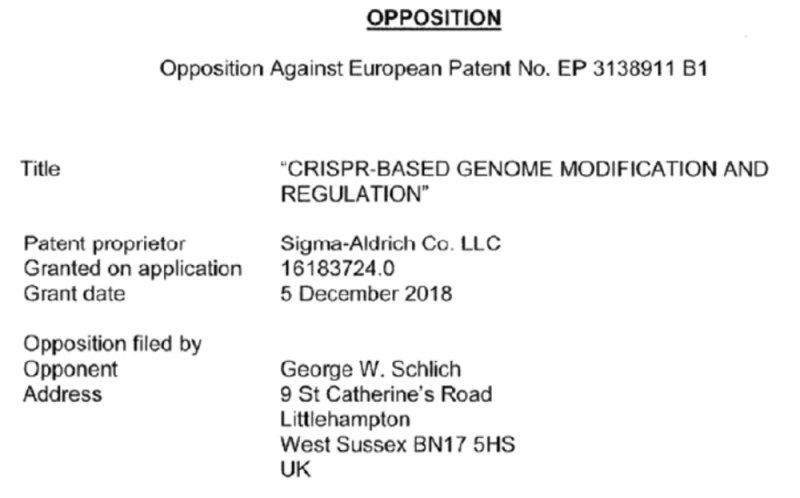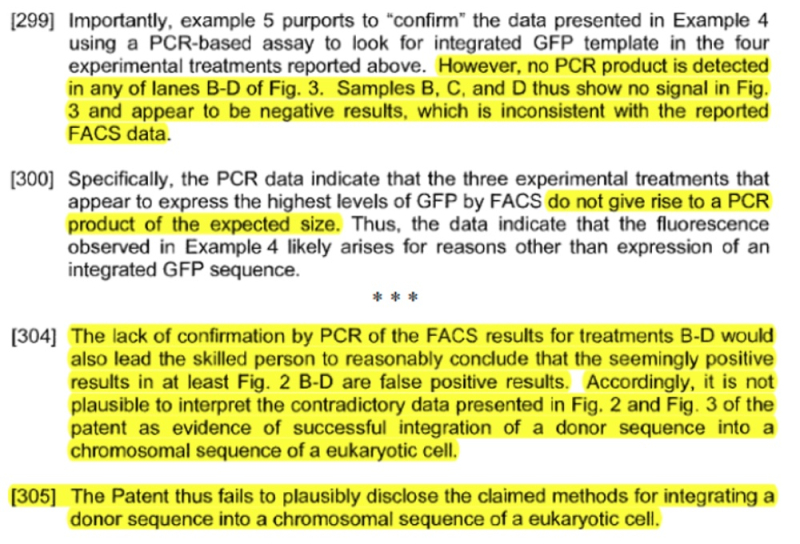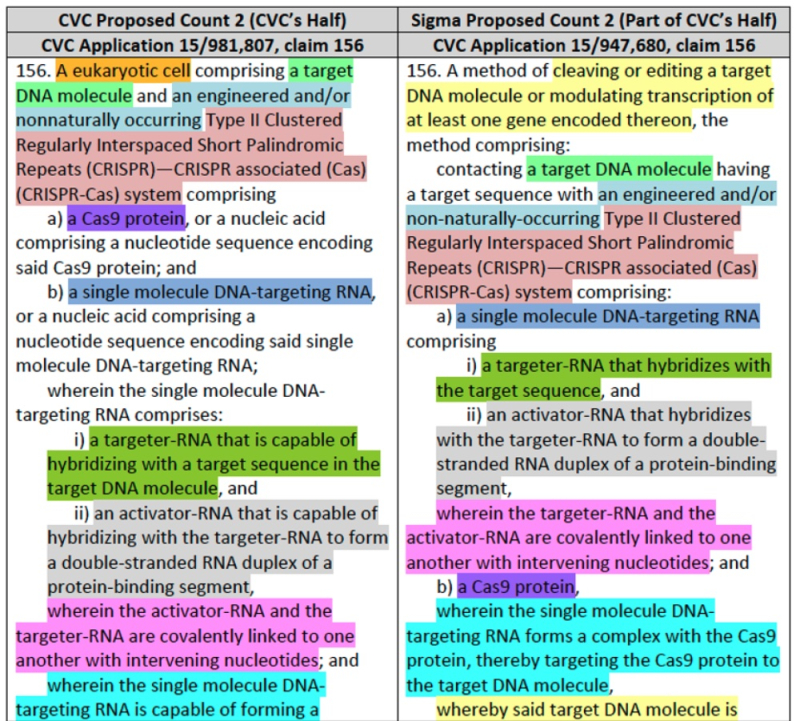The basis for CVC's motion was to change the Count to be limited to so-called "single (RNA) molecule guide RNA (sgRNA) species." CVC argued that substituting this Count is more symmetrical with CVC's portion of the Count and "avoids inconsistency" with the Counts in related interferences (see "CRISPR Battle Joined Again"; "The CRISPR Chronicles: Enter Toolgen"; and "Sigma-Aldrich Joins the CRISPR Interference Fray").
Sigma-Aldrich responds in its Opposition that, contrary to any nebulous (and "self-serving") "inconsistency," what CVC is actually trying to accomplish is to prevent Sigma-Aldrich from asserting its "best proofs" in the interference. Sigma-Aldrich contends it is the only party in any of the pending interferences -- CVC, ToolGen, and Broad -- having proofs of reducing to practice CRISPR in eukaryotic cells having both single-molecule RNA (sgRNA) and dual-molecule ("dgRNA") RNA species. CVC's proposed motion on its face and according to its arguments in its Motion No. 3 would change the Count to exclude dual-molecule RNA-comprising eukaryotic CRISPR. Sigma-Aldrich argues that any concerns CVC asserts regarding "inconsistency" and "the public interest" would be served by the Board granting its own Motion No. 1 (while characterizing CVC's concerns in this regard as being "á la Chicken Little's dire predictions, . . . highly remote and purely speculative at best." Also raising questions about CVC's "ulterior motives," Sigma-Aldrich contends that CVC's proposed Count would "not []enable CVC to better make out CVC's priority case, but instead [would] hamstring Sigma from making out Sigma's priority case" which "is not a legitimate basis to seek to change the count."
CVC has not carried its burden in making a showing that they are entitled to the relief sought, Sigma-Aldrich argues, because they have failed to assert the conventional basis for such a motion -- that it would enable CVC to proffer its best proofs in the interference. Instead, CVC asks the Board to alter the Count on the portion of the "McKelvey" Count taken from Sigma-Aldrich's claims, which request is but a "strategic maneuver to try to prejudice Sigma's ability to proffer its proofs of invention." And there is no dispute raised by CVC that Sigma-Aldrich's best proofs encompass eukaryotic CRISPR claims generic to the type of guide RNA molecule it contains, Sigma-Aldrich notes, because CVC's own Motion No. 3 expressly recites such a concession. These purported proofs comprise data in addition to FACS data provided for both guide RNA types, data which Sigma-Aldrich describes as "additional and confirmatory PCR data" (emphasis in brief) which is specifically provided for dgRNA (and not sgRNA) embodiments. According to Sigma-Aldrich, "CVC's strategic goal of its Motion 3 is an unfair (and thinly disguised) attempt to prejudice Sigma's ability to rely upon Sigma's dgRNA PCR confirmation data as a component of Sigma's proofs of invention," and "[t]he remainder of CVC's arguments, directed to supposed 'uniformity' among the various interferences, and the 'public interest,' are all smoke and mirrors designed to disguise CVC's true objective here, namely, to unfairly preclude Sigma from relying upon the entirety of the data from Sigma's successful experiments."
Sigma-Aldrich also asserts that there is a bit of rhetorical legerdemain in CVC's arguments to the extent CVC argues that "Sigma's proofs appear to be identical either way" (which Sigma-Aldrich disputes) (emphasis in brief). Sigma-Aldrich contends that CVC is well aware that its proofs regarding sgRNA and dgRNA are not "identical" based on an Opposition between the parties in a European Opposition, captioned thusly:

CVC's European representative, Mr. Schlich, was a "strawman" in the Opposition (which is perfectly acceptable in EPO practice). But Sigma-Aldrich sets out evidence (from "U.S. litigation proceedings," In re Schlich, Case No. 16-MC-319 (VSB) (S.D.N.Y. Sept. 18, 2017)) that he was in fact representing a CVC licensee, Intellia, a company having CVC inventor Jennifer Doudna as a principal:
 Tying up this evidence neatly, Sigma-Aldrich shows that, in the European Opposition CVC was well aware of the dgRNA embodiments it contends "apparently" are not at issue in this interference with regard to CVC's motion to change the Count, particularly with reference to "Lane A" which involves eukaryotic CRISPR results obtained using dgRNA:
Tying up this evidence neatly, Sigma-Aldrich shows that, in the European Opposition CVC was well aware of the dgRNA embodiments it contends "apparently" are not at issue in this interference with regard to CVC's motion to change the Count, particularly with reference to "Lane A" which involves eukaryotic CRISPR results obtained using dgRNA:

Sigma-Aldrich also asserts that CVC's arguments regarding its eukaryotic CRISPR embodiments incorrectly ascribe to Sigma's disclosure sgRNA species that are actually disclosed in its own Jinek et al. Science article (and will be familiar to readers following Interference No. 106,115, wherein the Board recently awarded priority to Broad), as shown in this figure:

Sigma-Aldrich further contends that CVC's expert, Dr. Bailey conceded during cross-examination that Sigma-Aldrich's P1 application (61/734,256) disclosed dgRNA embodiments of eukaryotic CRISPR used to practice CRISPR in eukaryotic cells.
Sigma-Aldrich also argues that CVC's Motion No. 3 would be moot should the Board grant Sigma-Aldrich's own motion (No. 1) to change the Count, providing a colorful comparison regarding CVC's portion of the Count in this interference between CVC's proposed Count and Sigma-Aldrich's:


Sigma-Aldrich takes the time in its Opposition to distinguish CVC's citation to precedent, In re Vivint, 14 F.4th 1342 (Fed. Cir. 2021), as being unavailing because that case was not an interference case and involved denial of an ex parte reexamination request that was "essentially identical" to a denied inter partes review petition.
Finally, Sigma-Aldrich argues that neither CVC's P1 nor P2 provisional applications provide a constructive reduction to practice of any embodiment falling within the scope of the proposed substitute Count in its Motion No. 3, citing Sigma-Aldrich's Opposition to CVC's Motion No. 1 (which recites many of the same arguments the Board found persuasive in awarding priority to Broad in the '115 Interference).
Sigma-Aldrich accordingly asks the Board to deny CVC's Substantive Preliminary Motion No. 3.